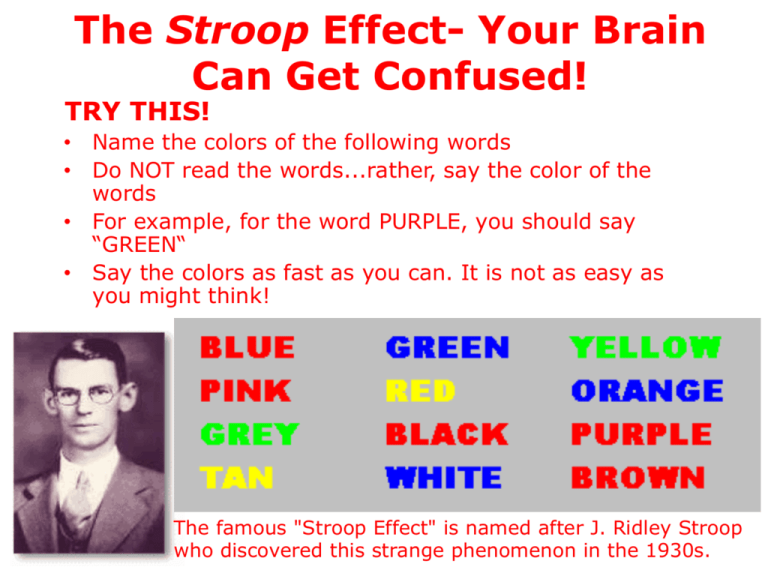File
advertisement

The Stroop Effect- Your Brain Can Get Confused! TRY THIS! • Name the colors of the following words • Do NOT read the words...rather, say the color of the words • For example, for the word PURPLE, you should say “GREEN“ • Say the colors as fast as you can. It is not as easy as you might think! The famous "Stroop Effect" is named after J. Ridley Stroop who discovered this strange phenomenon in the 1930s. • Today: – Nervous System – Interdependent Organ Systems – Medical Imaging Technologies • Tomorrow: – Quiz 3 – Collect Crossword Puzzle (2) – Organ Transplant – Time to work on poster project • Bring in your research, boards and other materials Neurons • Cells that carry information through your nervous system • The message that a neuron carries is called a nerve impulse The cell body has threadlike extensions The dendrite carries impulses toward the cell The axon carries impulses away from the cell Axons and dendrites are sometimes called nerve fibers • A bundle of nerve fibers is called a nerve. • • • • The Anatomy of a Neuron Central & Peripheral Nervous Systems Working Together The yellow parts are CNS parts and the purple are parts of your PNS. Your Brain- The Command Center • The human brain is a complex organ that allows us to think, move, feel, see, hear, taste, and smell • It controls our body, receives information, analyzes information, and stores information (our memories). • The brain produces electrical signals, which, together with chemical reactions, let the parts of the body communicate. Nerves send these signals throughout the body. Most nerve signals are interpreted by your brain and then your motor nerves carry out your instructions. Your Senses Are Your Nervous System’s Bridge to the Outside World Sight, Taste, Touch, Hearing, Smell Reflexes: Some nerve signals go only to the spinal cord and back. The knee jerk reflex There is only 1 synapse in the neural circuit needed to complete the reflex It only takes about 50 milliseconds of time between the tap and the start of the leg kick...that is fast Medical Imaging Technologies Medical Imaging Technologies • X-Ray – Diagnosis in cardiovascular systems respiratory system, mammograms, teeth – Able to penetrate soft tissue but not bone – Quick, painless, non-invasive – X-ray can cause changes and mutations to DNA – Image is formed when the x-ray, high energy radiation, passes through the body Medical Imaging Technologies • Fluoroscopy – Used to study the blood vessels of the heart and brain and movements of other organs • Cerebral angiogram and coronary angiogram – Patients required to ingest a contrast liquid (barium or iodine) or special dye is injected into an artery – Use continuous beams of x-ray Medical Imaging Technologies • Radiotherapy – Use X-ray to treat cancer – X-rays damage the DNA and either kill the cancer cells or prevent them from multiplying – The X-ray is directed at the tumour to minimize damage to healthy normal cells – May be combined with other forms of theraphy (surgery, chemotherapy) Medical Imaging Technologies • Ultrasound – Used on expecting mothers and heart problems – Cannot be used on bones or intestinal area (due to presence of gas) – Images produced by high-frequency sound waves, which reflect back off soft internal structures Medical Imaging Technologies • Computer Tomography (CT) • Computer Assisted Tomography (CAT) – Often used to diagnose cancer, abnormalities of the skeletal system, and vascular disease – Provide detailed cross-sectional view of structure – Can be used to image bone, soft tissue, and blood vessels at the same time – Relatively quick, painless – Use X-ray equipment to form a 3D image – Done by taking images from different angles Medical Imaging Technologies • Magnetic Resonance Imaging (MRI) – Useful for brain, heart, liver, soft tissues, and inside of bones – Used to diagnose cancer, brain diseases, cardiovascular conditions – Use powerful magnets and radiowaves – Human body is mostly water (H2O), which contain hydrogen atoms • The magnetic field interacts with these atoms Medical Imaging Technologies • Nuclear Medicine – Cancer, organ disorders, blood circulation – Use radioisotopes to form images of how tissues and organ function • Radioisotopes are radioactive form of elements (emit radiation) • Radioisotopes are attached to chemicals absorbed by certain tissues and organs • Camera and computer detect the radiation and form image – Can be used to treat diseases (thyroid, prostate, breast cancer) Medical Imaging Technologies • Positron Emission Tomography (PET) – Detection of cancer, heart disease, brain disorder, also can examine effects of cancer treatment – Patients are given radioisotope that emits particles called positrons, which is detected by the camera and computer to form an image Medical Imaging Technologies • Biophotonics – Digestive tract (gastrointestinal endoscopy, colonoscopy) – Useful in surgical techniques (removal of gallbladders and knee repairs) – Small incisions are made so the endoscope can be inserted – Use interactions of light with cells and tissues to diagnose and treat abnormalities • When light shines on cells, light particles are scattered by the cells’ atoms • A device records these scatter patterns • Abnormal cells create different scatter patterns than normal cells






![Physics of Radiologic Imaging [Opens in New Window]](http://s3.studylib.net/store/data/008568907_1-1e7d7b82bfd2882a3a695d3f7c130835-300x300.png)

